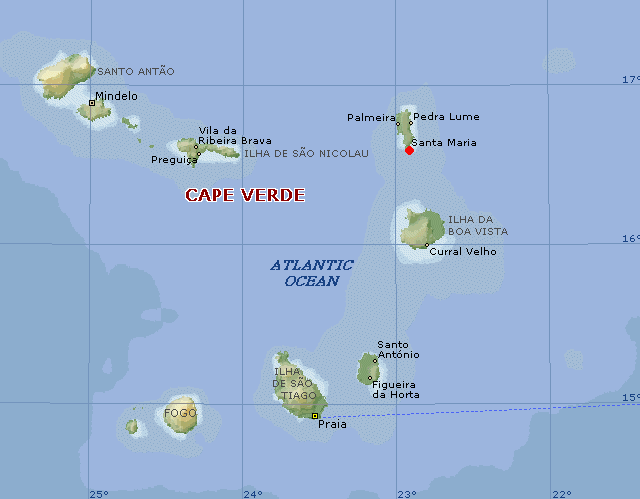Antonio Galvao
Cape Verde Islands (M)
The Cape Verde Islands are located on the continental shelf off the west coast of Africa and are a popular location for Europeans wishing to buy property in the sun. They would have been more extensive in area when the ocean levels were lower during the last Ice Age . Along with the Canaries, Azores, Madeira and some smaller North Atlantic islands they constitute ‘Macaronesia’.
When they were rediscovered in 1460 they were found to be uninhabited although they were noted as inhabited on earlier maps.  The 1413 map of the Catalan cartographer Mecia de Viladestes, which is thought to be based on Roman sources, shows islands at the same location named as Gades, a name that could be a diminutive of Gorgades or possibly derived from Gaderia one of the kingdoms of the Atlantis empire. In the 16th century the Cape Verde Islands were also shown with the alternative name of Dorcades, on the 1563 map of the Portuguese historian Antonio Galvao, which may just have been a corruption of Gorgades. A few years later in 1587 a map by the English geographer Richard Haklyut again applies the name Gorgades to the Cape Verde Islands. The identification of the Gorgades with the Cape Verde Islands is strongly defended by modern writers such as Andrew Collins.
The 1413 map of the Catalan cartographer Mecia de Viladestes, which is thought to be based on Roman sources, shows islands at the same location named as Gades, a name that could be a diminutive of Gorgades or possibly derived from Gaderia one of the kingdoms of the Atlantis empire. In the 16th century the Cape Verde Islands were also shown with the alternative name of Dorcades, on the 1563 map of the Portuguese historian Antonio Galvao, which may just have been a corruption of Gorgades. A few years later in 1587 a map by the English geographer Richard Haklyut again applies the name Gorgades to the Cape Verde Islands. The identification of the Gorgades with the Cape Verde Islands is strongly defended by modern writers such as Andrew Collins.
Although there is little support for identifying the Cape Verde Islands as Atlantis itself, there is willingness by some to see them as remnants of its empire. Without more clear-cut classical references and/or archaeological evidence, it would be unwise to put too much value on any Atlantean link with the archipelago.
Thomas K. Dietrich speculated[217, p70] that the Prime Meridian of ancient civilisations was centred on the Cape Verde Islands.
In 1949, Capt. H.P.C. Andersen, who worked for a Danish salvage company, wrote a very brief letter to Egerton Sykes‘ Atlantis Research journal with the self-explanatory title of Atlantean Traces in the Cape Verde Islands(a). In it, he recounts coming across a harbour in Boavista Island, the bottom of which was completely covered in sheets of concrete about a yard square, reminiscent of a market place.
A short YouTube clip(b) purporting to offer evidence for Atlantis at Cape Verde is available. It is based on Google Earth images, but is far from convincing.
(a) Atlantis Research (1949. 2.1. p13)
(b) https://www.youtube.com/watch?v=YDE__VnJvBA
